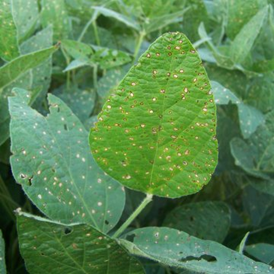Frogeye leaf spot is caused by the fungus Cercospora sojina. The fungus survives in crop debris from previous growing seasons, and produces spores (conidia) when conditions favor release. The fungus can affect soybeans at any growth stage, but symptoms are most commonly observed during reproductive stages. Young soybean leaves are most susceptible, while older leaves tend to be more resistant. Frogeye leaf spot is most severe when warm, humid weather with frequent rain persists for extended periods. if conditions are favorable and there are severe disease outbreaks early in the season or just after flowering, yield losses can be as high as 35% (Mueller, D. 2018).
Frogeye leaf spot is characterized by irregular to circular lesions, which are tan-to-gray in color with reddish-purplish borders. On some soybean varieties, you may also see a light green halo around the lesion border. Individual leaf spots can coalesce to create irregular patterns of blighting on the leaf. When fungal sporulation occurs, it gives the underside of lesions a gray and fuzzy appearance.
Stem and pod symptoms are less common, but may appear late in the growing. Stem lesions are elongated whereas pod lesions are circular.


.png?height=120&name=AgroScout_logo_Big_High_Resolution-(1).png)